I'm trying to make a cube, which is irregularly triangulated, but virtually coplanar, shade correctly.
Here is the current result I have:

With wireframe:
Normals calculated in my program:
Normals calculated by meshlabjs.net:
The lighting works properly when using regular size triangles for the cube. As you can see, I'm duplicating vertices and using angle weighting.
lighting.frag
vec4 scene_ambient = vec4(1, 1, 1, 1.0);
struct material
{
vec4 ambient;
vec4 diffuse;
vec4 specular;
float shininess;
};
material frontMaterial = material(
vec4(0.25, 0.25, 0.25, 1.0),
vec4(0.4, 0.4, 0.4, 1.0),
vec4(0.774597, 0.774597, 0.774597, 1.0),
76
);
struct lightSource
{
vec4 position;
vec4 diffuse;
vec4 specular;
float constantAttenuation, linearAttenuation, quadraticAttenuation;
float spotCutoff, spotExponent;
vec3 spotDirection;
};
lightSource light0 = lightSource(
vec4(0.0, 0.0, 0.0, 1.0),
vec4(100.0, 100.0, 100.0, 100.0),
vec4(100.0, 100.0, 100.0, 100.0),
0.1, 1, 0.01,
180.0, 0.0,
vec3(0.0, 0.0, 0.0)
);
vec4 light(lightSource ls, vec3 norm, vec3 deviation, vec3 position)
{
vec3 viewDirection = normalize(vec3(1.0 * vec4(0, 0, 0, 1.0) - vec4(position, 1)));
vec3 lightDirection;
float attenuation;
//ls.position.xyz = cameraPos;
ls.position.z += 50;
if (0.0 == ls.position.w) // directional light?
{
attenuation = 1.0; // no attenuation
lightDirection = normalize(vec3(ls.position));
}
else // point light or spotlight (or other kind of light)
{
vec3 positionToLightSource = vec3(ls.position - vec4(position, 1.0));
float distance = length(positionToLightSource);
lightDirection = normalize(positionToLightSource);
attenuation = 1.0 / (ls.constantAttenuation
+ ls.linearAttenuation * distance
+ ls.quadraticAttenuation * distance * distance);
if (ls.spotCutoff <= 90.0) // spotlight?
{
float clampedCosine = max(0.0, dot(-lightDirection, ls.spotDirection));
if (clampedCosine < cos(radians(ls.spotCutoff))) // outside of spotlight cone?
{
attenuation = 0.0;
}
else
{
attenuation = attenuation * pow(clampedCosine, ls.spotExponent);
}
}
}
vec3 ambientLighting = vec3(scene_ambient) * vec3(frontMaterial.ambient);
vec3 diffuseReflection = attenuation
* vec3(ls.diffuse) * vec3(frontMaterial.diffuse)
* max(0.0, dot(norm, lightDirection));
vec3 specularReflection;
if (dot(norm, lightDirection) < 0.0) // light source on the wrong side?
{
specularReflection = vec3(0.0, 0.0, 0.0); // no specular reflection
}
else // light source on the right side
{
specularReflection = attenuation * vec3(ls.specular) * vec3(frontMaterial.specular)
* pow(max(0.0, dot(reflect(lightDirection, norm), viewDirection)), frontMaterial.shininess);
}
return vec4(ambientLighting + diffuseReflection + specularReflection, 1.0);
}
vec4 generateGlobalLighting(vec3 norm, vec3 position)
{
return light(light0, norm, vec3(2,0,0), position);
}
mainmesh.frag
#version 430
in vec3 f_color;
in vec3 f_normal;
in vec3 f_position;
in float f_opacity;
out vec4 fragColor;
vec4 generateGlobalLighting(vec3 norm, vec3 position);
void main()
{
vec3 norm = normalize(f_normal);
vec4 l0 = generateGlobalLighting(norm, f_position);
fragColor = vec4(f_color, f_opacity) * l0;
}
Follows the code to generate the verts, normals and faces for the painter.
m_vertices_buf.resize(m_mesh.num_faces() * 3, 3);
m_normals_buf.resize(m_mesh.num_faces() * 3, 3);
m_faces_buf.resize(m_mesh.num_faces(), 3);
std::map<vertex_descriptor, std::list<Vector3d>> map;
GLDebugging* deb = GLDebugging::getInstance();
auto getAngle = [](Vector3d a, Vector3d b) {
double angle = 0.0;
angle = std::atan2(a.cross(b).norm(), a.dot(b));
return angle;
};
for (const auto& f : m_mesh.faces()) {
auto f_hh = m_mesh.halfedge(f);
//auto n = PMP::compute_face_normal(f, m_mesh);
vertex_descriptor vs[3];
Vector3d ps[3];
int i = 0;
for (const auto& v : m_mesh.vertices_around_face(f_hh)) {
auto p = m_mesh.point(v);
ps[i] = Vector3d(p.x(), p.y(), p.z());
vs[i++] = v;
}
auto n = (ps[1] - ps[0]).cross(ps[2] - ps[0]).normalized();
auto a1 = getAngle((ps[1] - ps[0]).normalized(), (ps[2] - ps[0]).normalized());
auto a2 = getAngle((ps[2] - ps[1]).normalized(), (ps[0] - ps[1]).normalized());
auto a3 = getAngle((ps[0] - ps[2]).normalized(), (ps[1] - ps[2]).normalized());
auto area = PMP::face_area(f, m_mesh);
map[vs[0]].push_back(n * a1);
map[vs[1]].push_back(n * a2);
map[vs[2]].push_back(n * a3);
auto p = m_mesh.point(vs[0]);
deb->drawLine(Vector3d(p.x(), p.y(), p.z()), Vector3d(p.x(), p.y(), p.z()) + Vector3d(n.x(), n.y(), n.z()) * 4);
p = m_mesh.point(vs[1]);
deb->drawLine(Vector3d(p.x(), p.y(), p.z()), Vector3d(p.x(), p.y(), p.z()) + Vector3d(n.x(), n.y(), n.z()) * 4);
p = m_mesh.point(vs[2]);
deb->drawLine(Vector3d(p.x(), p.y(), p.z()), Vector3d(p.x(), p.y(), p.z()) + Vector3d(n.x(), n.y(), n.z()) * 4);
}
int j = 0;
int i = 0;
for (const auto& f : m_mesh.faces()) {
auto f_hh = m_mesh.halfedge(f);
for (const auto& v : m_mesh.vertices_around_face(f_hh)) {
const auto& p = m_mesh.point(v);
m_vertices_buf.row(i) = RowVector3d(p.x(), p.y(), p.z());
Vector3d n(0, 0, 0);
//auto n = PMP::compute_face_normal(f, m_mesh);
Vector3d norm = Vector3d(n.x(), n.y(), n.z());
for (auto val : map[v]) {
norm += val;
}
norm.normalize();
deb->drawLine(Vector3d(p.x(), p.y(), p.z()), Vector3d(p.x(), p.y(), p.z()) + Vector3d(norm.x(), norm.y(), norm.z()) * 3,
Vector3d(1.0, 0, 0));
m_normals_buf.row(i++) = RowVector3d(norm.x(), norm.y(), norm.z());
}
m_faces_buf.row(j++) = RowVector3i(i - 3, i - 2, i - 1);
}
Follows the painter code:
m_vertexAttrLoc = program.attributeLocation("v_vertex");
m_colorAttrLoc = program.attributeLocation("v_color");
m_normalAttrLoc = program.attributeLocation("v_normal");
m_mvMatrixLoc = program.uniformLocation("v_modelViewMatrix");
m_projMatrixLoc = program.uniformLocation("v_projectionMatrix");
m_normalMatrixLoc = program.uniformLocation("v_normalMatrix");
//m_relativePosLoc = program.uniformLocation("v_relativePos");
m_opacityLoc = program.uniformLocation("v_opacity");
m_colorMaskLoc = program.uniformLocation("v_colorMask");
//bool for unmapping depth color
m_useDepthMap = program.uniformLocation("v_useDepthMap");
program.setUniformValue(m_mvMatrixLoc, modelView);
//uniform used for Color map to regular model switch
program.setUniformValue(m_useDepthMap, (m_showColorMap &&
(m_showProblemAreas || m_showPrepMap || m_showDepthMap || m_showMockupMap)));
QMatrix3x3 normalMatrix = modelView.normalMatrix();
program.setUniformValue(m_normalMatrixLoc, normalMatrix);
program.setUniformValue(m_projMatrixLoc, projection);
//program.setUniformValue(m_relativePosLoc, m_relativePos);
program.setUniformValue(m_opacityLoc, m_opacity);
program.setUniformValue(m_colorMaskLoc, m_colorMask);
glEnableVertexAttribArray(m_vertexAttrLoc);
m_vertices.bind();
glVertexAttribPointer(m_vertexAttrLoc, 3, GL_DOUBLE, false, 3 * sizeof(GLdouble), NULL);
m_vertices.release();
glEnableVertexAttribArray(m_normalAttrLoc);
m_normals.bind();
glVertexAttribPointer(m_normalAttrLoc, 3, GL_DOUBLE, false, 0, NULL);
m_normals.release();
glEnableVertexAttribArray(m_colorAttrLoc);
if (m_showProblemAreas) {
m_problemColorMap.bind();
glVertexAttribPointer(m_colorAttrLoc, 3, GL_DOUBLE, false, 0, NULL);
m_problemColorMap.release();
}
else if (m_showPrepMap) {
m_prepColorMap.bind();
glVertexAttribPointer(m_colorAttrLoc, 3, GL_DOUBLE, false, 0, NULL);
m_prepColorMap.release();
}
else if (m_showMockupMap) {
m_mokupColorMap.bind();
glVertexAttribPointer(m_colorAttrLoc, 3, GL_DOUBLE, false, 0, NULL);
m_mokupColorMap.release();
}
else {
//m_colors.bind();
//glVertexAttribPointer(m_colorAttrLoc, 3, GL_DOUBLE, false, 0, NULL);
//m_colors.release();
}
m_indices.bind();
glDrawElements(GL_TRIANGLES, m_indices.size() / sizeof(int), GL_UNSIGNED_INT, NULL);
m_indices.release();
glDisableVertexAttribArray(m_vertexAttrLoc);
glDisableVertexAttribArray(m_normalAttrLoc);
glDisableVertexAttribArray(m_colorAttrLoc);
EDIT: Sorry for not being clear enough. The cube is merely an example. My requirements are that the shading works for any kind of mesh. Those with very sharp edges, and those that are very organic (like humans or animals).





